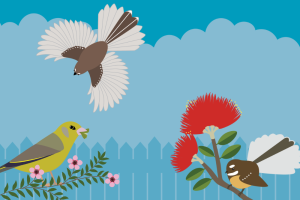
Female house sparrow. Image: Andrew Walmsley
The survey, run by Manaaki Whenua, has been held annually since 2007.
At the end of June, we invite members of the public to become citizen scientists for an hour and count the number of birds in their garden.
This year, more than 15,000 people took part nationally, submitting over 6,000 surveys. The numbers of birds counted were also similar to the numbers counted last year, both at a national and local level, says survey founder Dr Eric Spurr.
Nationally, the top 10 species were house sparrow (tiu), silvereye (tauhou), blackbird (manu pango), starling (tāringi), tūī, fantail (pīwakawaka), myna (maina), greenfinch, rock pigeon (kererū toka), and song thrush (tarāhi waiata), the same order as last year.
Of these, only three species are native; silvereye, tūī, and fantail, with four other native species occurring in the top 20; kererū, welcome swallow (warou ‘nau mai’), kingfisher (kōtare), and grey warbler (riroriro).
Based on preliminary results, the counts of all native species appear to be the same or greater than last year. Final results of the 10- and 5-year trends to 2022 are expected later in the year.
This year Nelson bird enthusiasts swooped in and knocked Otago off its perch as the country’s top counting region on a per capita basis – a title they’ve held for years. We sense a challenge may be on for the 2023 New Zealand Garden Bird Survey.

